Choose the right bird
Check and see if local sellers are offering fresh chickens at the nearest farmers market. If not, you could order heirloom breeds or sustainably raised chickens from such trusted vendors at Porter Road or D'Artagnan. Or look for air-chilled birds at better grocers near your place. Don't be thrown off by a term like "fryer," at the butcher's case, which simply means the chicken is the right size for frying. You can roast a fryer or a broiler.
Prep the skin
This is important. To get that deliciously crispy brown skin—most people's highlight of the dish—you want to bring the raw chicken as close to room temperature as possible. Let it set out for 30 minutes to an hour before roasting. Pat the chicken dry with paper towels, making sure to absorb any liquid behind the wings or legs. Blot inside the body cavity too, getting the chicken as dry as you can inside and out.

Season it liberally
Rub a thin layer of oil or softened butter all over the chicken, paying special attention to the breast, as well as the drumsticks. This will help brown the skin and get it nice and crisp. Generously sprinkle the chicken all over with salt and pepper. If you'd like to add any citrus, garlic or herbs to the cavity, toss them in.
Nail the trussing
Fold back the wings under the body and tie the legs together, close to the body with kitchen twine. (You can also use dental floss in a pinch.) It doesn't have to be perfect, but it's worth the effort, because a compact chicken cooks more evenly and helps retain more of the natural juices.

Place it in the pan
Place your trussed and seasoned chicken breast-side up in a cast iron skillet, (or roasting pan, baking dish, pie plate, or any other shallow ovenproof dish). You can roast the chicken by itself in the pan, or place it atop coarsely chopped vegetables for an easy one-pan dish.
Let it roast, then rest
Place the chicken in an oven preheated to 450°, then immediately turn the temperature down to 400° when you put the bird in. Let it roast for 60 minutes at 400°, undisturbed. The chicken is done when it registers 165° in the thickest part of the thigh. If you don't have a meat thermometer, that's when the wings and legs wiggle loosely, and when the juices run clear. Transfer the chicken to a clean cutting board and let it rest for at least 10 minutes.
Want a sauce?
After you've roasted the chicken, turn the drippings into a tasty gravy. Deglaze the pan with a little chicken stock or white wine, and bring the liquid to a simmer. Make sure to scrape up all of the brown bits at the bottom of the pan. When it's as thick as you like it, give it a final season of salt and pepper (to taste), then drizzle it over the carved chicken when plating it.




